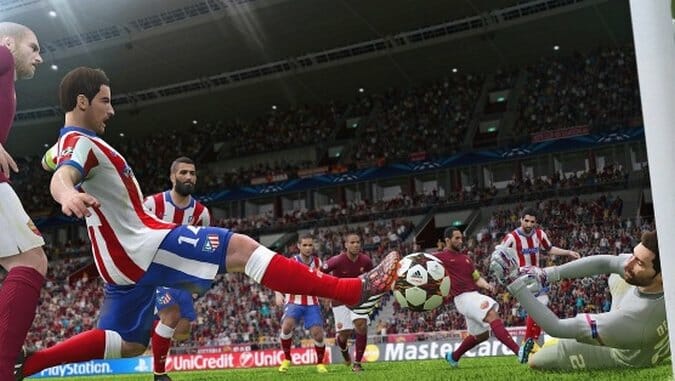Pro Evolution Soccer 2015: Second Division

Over the past few years, the majority of my videogame playing time has been taken up by soccer games. The one I play the most, Football Manager, aims to simulate the hardcore nuts and bolts of coaching a soccer team, a sometimes Dwarf Fortressian task that has morphed the series into a cult classic (see the recent documentary about the series for proof of this status).
At the other end is FIFA. This is where I go when I want glitz and glamour. FIFA, to me, is less about simulating a “real” soccer match and more about the sounds and sights. I play it to feel that slight rumble in my chest when the sound is cranked up and the crowd roars after a Podolski screamer in the top left of the net. I am remarkably easy to enthrall when it comes to sports games: I want realistic noise and faces, the rest be damned.
Which is where Pro Evolution Soccer 2015 comes in. PES aims to occupy a middle ground between Football Manager’s dry tactical realism and FIFA’s high gloss style. Unfortunately, it doesn’t seem to do any one thing well enough to distinguish it.
PES doesn’t really attempt to compete with Football Manager, but it’s worth comparing the two as a means of distinguishing PES from its direct competitor, FIFA. FIFA has long been a bit short in the tactical realism department, eschewing the ability to tinker with your tactics in any deep way for quick, arcadey instructions to get on with the game.
While clearly not going into Football Manager territory, PES allows for much more robust control over the tactical aspects of the game. The main tactics creation/tweaking screen allows for finite control of player positioning. FIFA tried to get on this in this year’s offering but PES simply does it better, not least because the position a player is in changes dynamically based on where he is on the pitch. This means that a right attacking midfielder becomes a right wing in real time, with the attendant effects on players being played out of position.
This tactical sensitivity extends to the actual gameplay, where new tactics can be implemented on the fly. This offers a deeper approach to FIFA’s simple (yet, admittedly, effective) commands of “press higher” or “offside trap”. It’s an approach rewarding of work put in to understanding the system, but there is a learning curve with all of this that FIFA, with its jump in and play readiness, doesn’t have.
The game plays slower as a result, though this isn’t a bad thing. It’s arguably more realistic; patient prodding of the opposition is rewarded in PES in a way which FIFA doesn’t. It allows for the rhythm of soccer to be presented a bit more realistically than FIFA’s smash and grab, perpetual route one gameplay. The problem is that this added realism is let down by poor production values in the way the players move and look.
There’s simply no delicate way of putting it: I found PES to be a remarkably ugly game and the animations to be not much better. For all the realism on the tactical side, players seem to share a single body type, no matter how big or small they are in real life. This means that Mesut Ozil, Arsenal’s rail-thin German playmaker, looks strangely beefy in-game. In fact, all of the players look equally beefy, like they came off of a bodybuilder assembly line, meaning that telling one from another was difficult in game when compared to FIFA’s ability to eyeball test a player from afar.
The players’ faces slip right into the uncanny valley. The faces are correct; they’re modeled on photos and look like the players. But the large, singular body type and, more importantly, the lack of what can only be described as competent modeling of facial emotions turns the players into near monstrosities whenever an emotional moment in the game is reached. There are no visual bugs or anything so directly simple. It’s that the players’ faces display emotions in the way an android might. A shot is missed and the shooter’s mouth opens wide in disappointment, only it’s a little too wide, it’s accompanied by unblinking eyes (seriously, the players never, ever blink that I can see), and every single other player has the exact same facial expression. This undoubtedly is only going to matter to a small subset of the audience, but I found it downright distracting.
The animations and physics felt equally off. There’s something rather sudden about the way certain animations would occur. A player would turn smoothly one way, only to feel as though a half-frame had been skipped when he cut back. Shots felt very sudden, as well, with the time from build-up to release feeling very jerky.
-

-

-

-

-

-

-

-

-

-

-

-

-

-

-

-

-

-

-

-

-

-

-

-

-

-

-

-

-

-

-

-

-

-

-

-

-

-

-

-









































